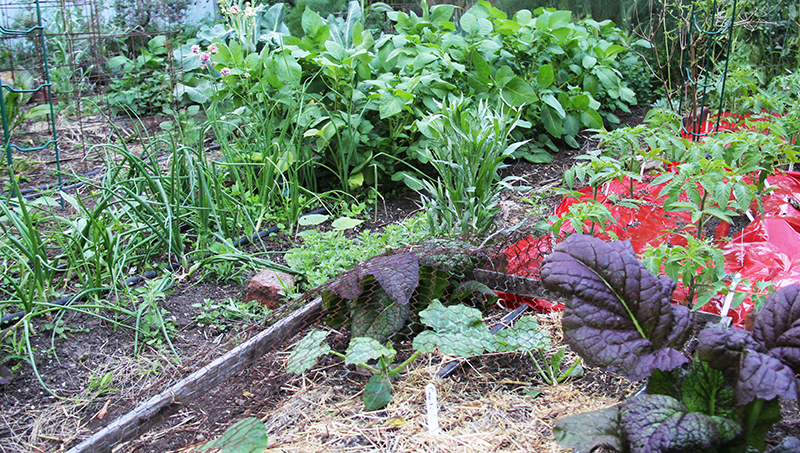by Linda Carloni, ABG Board member and Master Gardener
Some things about vegetable gardening do need to be learned by experience: How much zucchini will your family really eat? What does fertile soil feel like? Other really valuable information can be learned from books and online sources. Shared knowledge from experienced food growers is another great resource, and experienced food gardeners usually love to share the tips and tricks they’ve picked up by getting their hands dirty. Here are some tips and tricks from Alameda food growers.
Give them your attention
Get out in the garden and look carefully at your plants at least every other day. Needs and issues are more easily solved when they are recent and small.
- Look for signs of insects or snails eating the plants. Shake the plants to see what falls off and look at both sides of leaves for snails and slugs, caterpillars and similar worm-like critters. Hand pick them off before they get too much of your plants. I squish mine, but if you or a friend has chickens, the chickens will enjoy them greatly.
- Wilted leaves frequently mean a thirsty plant. So stick your finger or a moisture meter into the soil and see if it’s dry. Exception: in hot afternoons, tomatoes will frequently wilt even though they have sufficient soil moisture. Check in the evening or the next morning to see if the tomato actually needs more water.
- Look to see whether leaves or the veggies themselves are resting on the ground. That’s an invitation for diseases and pests, so snip off leaves resting on the ground, and prop up the stems that are holding the veggies so they don’t drag.
Baby Plants
Just sprouted seedlings and seedlings you’ve transplanted are more fragile than plants that are further along. Surrounding the baby plant with a plastic milk jug with top and bottom cut off protects the young ones from wind and discourages snails and slugs from munching them to the ground. Push the bottom edge of the jug into the surface of the soil as best you can to keep it in place.
Hot Weather
Warmer than normal temperatures require vigilance, especially for plants in pots.
- The soil in pots tends to dry out more quickly than does the ground. Pots have less room to store water in the pot soil and of course plants in pots can’t access groundwater. If a particularly warm day is forecast, try to go out early in the day and irrigate your plants in pots, unless they are already pretty damp. Plants in the ground may also appreciate a little extra water before the day gets really warm.
- Consider moving plants that don’t like a lot of sun and heat, such as leafy greens, into a shadier spot. My lettuce was very productive earlier in the year in the warmest sunniest spot I have, but now I need to move the pot to my shadier backyard.
- Likewise, if your sun/shade patterns have shifted so that your plants are getting too little sun, move them to a spot that’s now sunnier.
When the Party’s Over
Some of your plants may already have produced what they are going to produce and be dying back. Especially if you planted early, your radishes and lettuce may already be finished. You can still plant seeds now. Green beans and cucumbers should still work well from seeds. Lettuce can be planted all year, but be sure to give it some shade in the really hot days. All seeds need to be kept moist on the surface until they’ve germinated. Check the “days to maturity”on the seed packet, and select a variety that’s shorter rather than longer. If you’re planting in the same place as your previous crop, be sure to dig in some compost, and consider also adding a balanced vegetable fertilizer. You can keep your harvest party going through the summer!

